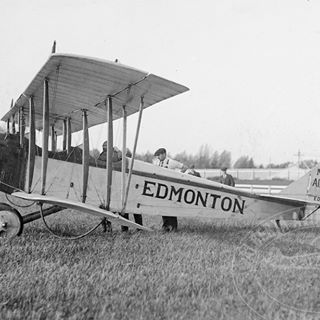 Your Local Military Relocation Expert is familiar with Edmonton, its history and its neighborhoods. When wanting to Buy the Right House at the Right Price visit Canada’s Largest Directory of Military Realtors.
Your Local Military Relocation Expert is familiar with Edmonton, its history and its neighborhoods. When wanting to Buy the Right House at the Right Price visit Canada’s Largest Directory of Military Realtors.
Visit Canada’s Largest Directory of Military Relocation Realtors.
The history of CFB Edmonton begins at an old airfield called Blatchford Field (named after a former mayor of Edmonton, Kenny Blatchford), a few kilometres south from where CFB Edmonton would eventually be established. The airfield began operating after the First World War and became important to the opening up and development of the Canadian north. During the Second World War Blatchford Field became a Royal Canadian Air Force (RCAF) training station under the British Commonwealth Air Training Plan. No. 16 Elementary Flying Training School (No. 16 EFTS) and No. 2 Air Observers School (No. 2 AOS) used the aerodrome. The RCAF also ran No. 4 Initial Training School (No. 4 ITS) which was a ground school located at the University of Alberta.[3] No. 16 EFTS closed in 1942 and No. 2 AOS closed in 1944. After No. 2 AOS closed, the station formally became known as RCAF Station Edmonton. Many RCAF squadrons and units were located here, including a survival school and the RCAF Winter Experimental Establishment (WEE). A United States Army Air Forces (USAAF) B-29 bomber detachment also used the station.
Edmonton, Alberta is located astride the banks of the North Saskatchewan River. The provincial capital is Canada’s sixth largest city and is often referred to as “Gateway to the North”. Edmonton also holds the title “Canada’s Festival City” as it celebrates a wide range of culture, music, theatre, visual arts and sports. The City of Edmonton’s 2001 population increased by 49,800 since the 1996 census. Migration figures are not available at the municipal level but data for the Edmonton CMA (census metropolitan area), shows that 63% of the CMA’s increase was from net-migration with 37% from natural increase.
In 1754, Anthony Henday, an explorer working for the Hudson’s Bay Company (HBC), may have been the first European to enter the Edmonton area.[16] His expeditions across the Canadian Prairies were mainly to seek contact with the aboriginal population for the purpose of establishing the fur trade, as competition was fierce between the Hudson’s Bay Company and the North West Company. By 1795, Fort Edmonton was established on the north bank of the river, as a major trading post for the Hudson’s Bay Company.[17] The name of the new fort was suggested by John Peter Pruden after Edmonton, London, the home town of both the HBC deputy governor Sir James Winter Lake, and Pruden.
The coming of the CPR to southern Alberta in 1885 helped the Edmonton economy, and the 1891 building of the Calgary and Edmonton Railway resulted in the emergence of a railway townsite (South Edmonton/Strathcona) on the south side of the river, across from Edmonton. The arrival of the CPR and the Calgary & Edmonton Railway facilitated the arrival of settlers and entrepreneurs from eastern Canada, Britain and continental Europe, U.S. and other parts of the world. The fertile soil and cheap land in the Edmonton area helped attract settlers, further establishing Edmonton as a major regional commercial and agricultural centre. Some people participating in the Klondike Gold Rush passed through South Edmonton/Strathcona in 1897. Strathcona was the northernmost railway point in North America, but travel to the Klondike was still very difficult for the “Klondikers,” and a majority of them took a steamship north to the Yukon from Vancouver.
There are four main hospitals serving Edmonton: University of Alberta Hospital, Royal Alexandra Hospital, Misericordia Community Hospital, and Grey Nuns Community Hospital.[180] Other area hospitals include Sturgeon Community Hospital in St. Albert, Leduc Community Hospital in Leduc, Westview Health Centre in Stony Plain, and Fort Saskatchewan Health Centre in Fort Saskatchewan. Dedicated psychiatric care is provided at the Alberta Hospital. All hospitals are under the administration of Alberta Health Services, although Misericordia and Grey Nuns are run separately by the Covenant Health.
Sport Fans will be delighted by seeing a home game of the Edmonton Oilers at Northlands Coliseum during ice-hockey season (October to April). The Commonwealth Stadium is home to the Edmonton Eskimos, who play CFL football from July to October. If you are more into baseball, try a game of the Edmonton Trappers (Pacific Coast Baseball League) at Telus Park (April to August). Cycling and hiking enthusiasts will be thrilled by the city’s vast network of park trails that are ideal for cross-country skiing in winter.
Edmonton also hosts the log and cottage show, a show built specifically for log and timber frame builders and crafters to showcase their products, plus the many suppliers that support one of the ‘coolest’ industry’s around. Also supported by development and real estate companies offering ideal acreage and lakeside opportunities.
Want to find out more about Brookfield GRS Military Relocation Information , then visit www.irp-dnd.com. Need a professional Angus Borden DND and IRP Home Inspectionsfor your Real Estate needs.
Read more about Edmonton’s Military Relocation Realtor.
